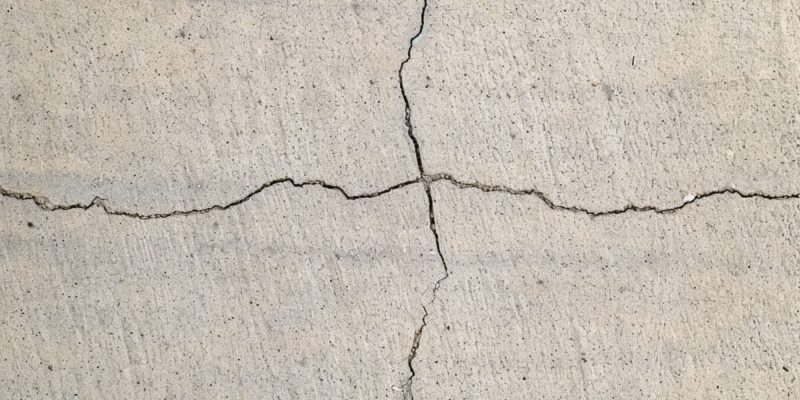Dealing with hairline cracks in your concrete surfaces can be a nuisance, but fear not. This guide will walk you through a straightforward, do-it-yourself approach to fixing these minor imperfections. Whether you’re a seasoned DIYer or new to home repairs, you’ll find this guide filled with practical steps to restore your concrete surfaces efficiently.
Understanding Hairline Cracks in Concrete
Hairline cracks in concrete are thin, superficial cracks often found in driveways, sidewalks, and walls. Typically less than an eighth of an inch wide, these cracks may seem minor but can lead to bigger problems if ignored. They often result from the natural settling of the ground, temperature changes, or the concrete drying too quickly when it was poured. In Rockford, where we experience diverse weather conditions, these cracks are a common sight in many homes.
Ignoring hairline cracks can allow water to seep in, leading to more significant damage, especially during freeze-thaw cycles typical in Illinois. Addressing these cracks promptly can save you time and money in the long run, preventing the need for more extensive repairs. Understanding the nature of these cracks is the first step in effectively dealing with them.
Preparing for the Repair
Before diving into the repair, proper preparation is key. Start by closely examining the crack to ensure it’s a hairline crack and not something more serious. If it’s wider than an eighth of an inch, it might require a professional look.
Next, clean the area thoroughly. Remove any loose material, dirt, or debris from the crack and its surrounding area. This can be done using a brush or a vacuum cleaner. A clean surface ensures the repair material adheres properly, making the fix more durable.
Now, let’s talk about materials. For hairline cracks, a concrete crack filler or a concrete patching compound works best. These are readily available at most hardware stores in Rockford. Choose a filler that is flexible, weather-resistant, and suitable for the size and location of your crack. Remember, the right material not only fixes the crack but also prevents it from reappearing.
With the crack assessed, cleaned, and the right materials in hand, you’re all set to begin the actual repair process.
Tools and Materials Needed for the Repair
For a successful DIY repair of hairline concrete cracks, you’ll need the following tools and materials:
- Concrete Crack Filler or Sealant: Choose a product suitable for the size and location of the crack, as well as the local climate conditions in Rockford.
- Putty Knife or Caulking Gun: Depending on the type of filler, a putty knife or a caulking gun will be needed for application.
- Wire Brush: To clean out the crack and remove any loose material.
- Vacuum Cleaner: To thoroughly clean the crack and surrounding area after brushing.
- Safety Glasses and Gloves: Always prioritize safety when dealing with repair materials.
- Concrete Sealant (Optional): For sealing the repaired area, especially in outdoor settings, to protect against moisture and weather elements.
Step-by-Step Repair Process
Repairing hairline cracks in concrete is a manageable task if you follow these steps carefully:
Step 1: Applying the Repair Solution
- Mix the Filler: If your chosen filler requires mixing, follow the manufacturer’s instructions precisely. For pre-mixed fillers, this step can be skipped.
- Application: Using a putty knife or similar tool, apply the filler into the crack. Be generous but precise, ensuring the filler penetrates the full depth of the crack. This might require a bit of pressure, especially for narrower cracks.
- Smooth It Out: After filling the crack, smooth out the surface. This not only makes it look better but also ensures the filler bonds evenly with the concrete.
Step 2: Smoothing and Finishing
- Wait for It to Settle: Allow the filler to settle for a few minutes. Refer to the product instructions for the exact time.
- Final Touches: Once the filler starts to harden, go over the surface again with your tool to ensure it’s flush with the surrounding concrete. This step is crucial for a seamless and aesthetically pleasing repair.
Step 3: Curing and Drying
- Curing Time: Different products have varying curing times. It could range from a few hours to a day. During this time, keep the repaired area free from traffic.
- Checking the Seal: Once cured, inspect the repair. A good repair job won’t reveal the crack, and the filler should feel firm to the touch.
NOTE
By following these steps, you can effectively repair hairline cracks in your concrete. Patience is key – don’t rush the process. Ensure each step is completed thoroughly for a long-lasting repair.
Aftercare and Prevention
After repairing your concrete, it’s crucial to take steps to maintain it and prevent future cracks. Here are some tips:
- Sealing: Apply a concrete sealant over the repaired area and surrounding concrete. This helps protect against moisture, chemicals, and temperature changes, common in Rockford.
- Regular Inspection: Periodically inspect your concrete surfaces for new cracks or signs of wear. Early detection makes repairs easier and less costly.
- Proper Drainage: Ensure water drains away from concrete surfaces. Water accumulation can weaken concrete and lead to cracking.
- Avoid Heavy Loads: Avoid placing heavy objects on areas that are prone to cracking.
Adapting to Local Conditions
In Rockford, Illinois, our concrete structures face unique challenges due to the region’s climatic conditions. Understanding these can help tailor your repair approach for better, longer-lasting results:
- Weather Considerations: Rockford experiences a range of weather conditions, from hot summers to freezing winters. These temperature fluctuations can cause concrete to expand and contract, leading to cracks. When repairing cracks, consider the season. In colder months, use a filler that can withstand freezing temperatures.
- Local Concrete Composition: The type of concrete used in our region may vary. Some may have specific aggregate mixes that respond differently to repairs. It’s worthwhile to consult with a local hardware store or a professional to understand the best match for your concrete type.
- Moisture Levels: Our area can be quite humid, especially in summer. High moisture levels can affect the curing process of the filler. Always check the weather forecast before starting your repair and choose a dry day for the best results.
- Preventing Future Cracks: Given our weather patterns, consider applying a waterproof sealant to your concrete surfaces annually. This can greatly reduce the likelihood of future cracks.
Professional vs. DIY Repair
Deciding whether to tackle concrete crack repair yourself or call in a professional depends on several factors:
- Crack Size and Severity: For hairline cracks, a DIY approach is usually sufficient. However, if you encounter wider or deeper cracks, or if they are in a structurally significant area, it’s safer to consult a professional.
- Skill and Confidence Level: If you’re comfortable with basic home improvement tasks, repairing hairline cracks should be manageable. If you’re unsure or uncomfortable with the process, professional help might be a better option.
- Time and Cost: DIY can be more cost-effective but requires your time and effort. Professional repairs will be more costly but are typically quicker and come with guarantees.
Remember, while DIY repairs are great for minor issues, there’s no substitute for professional expertise when it comes to more serious or complex concrete damage.
Conclusion
Congratulations, Rockford homeowners! You’re now equipped with the knowledge to tackle hairline concrete crack repairs. Remember, prompt action is key to preventing small cracks from becoming big problems. With the right tools and a bit of patience, you can keep your concrete surfaces looking great and functioning well. Happy repairing, and here’s to maintaining beautiful, durable concrete at home!

